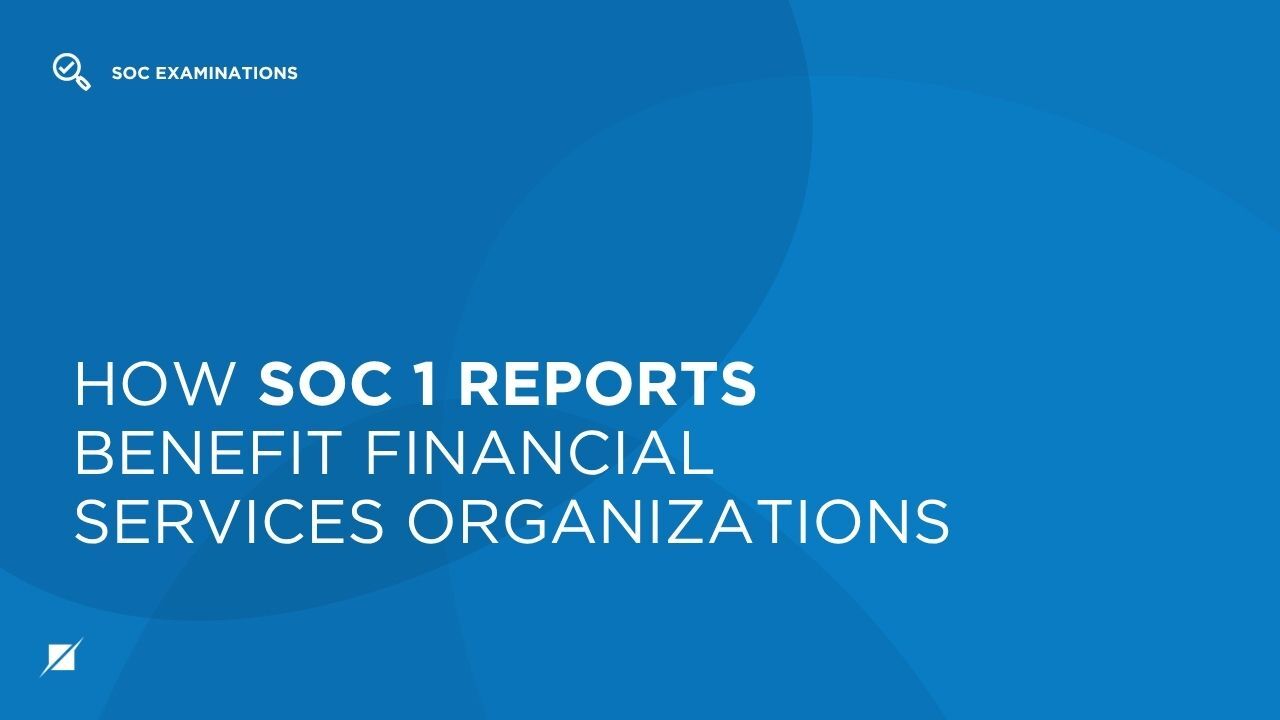How SOC 1 Reports Benefit Financial Services Organizations
Published: May 2, 2017
Last Updated: Oct 27, 2025
You may be wondering why a financial services company would need a SOC 1 report. Well, in today’s financial services landscape, trust is currency—and transparency is the key to earning it.
As clients (and in some cases, regulators) place increasing pressure on organizations to demonstrate strong internal controls, the need for independent assurance has never been greater. For financial services providers whose operations have an impact on their customers’ internal control over financial reporting (ICFR), a SOC 1 report isn’t just a compliance checkbox—it’s a vital tool for building credibility, managing risk, and unlocking growth.
Who Can Benefit from a SOC 1 Report?
Services impacting a customer’s ICFR would warrant a need for a SOC 1 and could potentially also satisfy some regulatory requirements.
Illustrative control objective areas for business operations related to handling transactional activity, as defined by the AICPA, could include those that provide reasonable assurance that transactions are:
- Authorized and received only from authorized sources
- Validated in a complete, accurate, and timely manner
- Entered, processed, recorded, and reported in a complete manner
- Entered, processed, recorded, and reported in an accurate manner
- Entered, processed, recorded, and reported in a timely manner
- Recorded and reported in the proper accounts
In addition to the business operations areas, many financial services companies develop and host applications for customers to handle the transactional activity related to the services being provided. In such instances, the scope of the SOC 1 report would expand to include general information technology controls that support such infrastructure and/or applications.
Illustrative Control Objective Areas
Illustrative control objective areas for such controls, as defined by the AICPA, could include information security, change management, and computer operations, as described below.
Information Security
Control activities provide reasonable assurance that:
- Logical access to programs, data, and computer resources is restricted to authorized and appropriate users, and such users are restricted to performing authorized and appropriate actions.
- Physical access to computers and other resources is restricted to authorized and appropriate personnel.
Change Management
Control activities provide reasonable assurance that:
- Changes to application programs and related data management systems are authorized, tested, documented, approved, and implemented to result in the complete, accurate, and timely processing and reporting of transactions and balances.
- Network infrastructure is configured as authorized to:
- support the effective functioning of application controls to result in valid, complete, accurate, and timely processing and reporting of transactions and balances and
- protect data from unauthorized changes.
Computer Operations
Control activities provide reasonable assurance that:
- Application and system processing are authorized and executed in a complete, accurate, and timely manner, and deviations, problems, and errors are identified, tracked, recorded, and resolved in a complete, accurate, and timely manner.
- Data transmissions between the service organization and its user entities and other outside entities are from authorized sources and are complete, accurate, secure, and timely.
- Data is backed up regularly and is available for restoration in the event of processing errors or unexpected processing interruptions.
How SOC 1 Reports Benefit Financial Services Companies
A SOC 1 report benefits a financial services company in the following ways:
- Builds client trust and credibility
- Demonstrates that your processes related to financial reporting are well-controlled and audited by an independent third party.
- Instills confidence in current and prospective clients that their data and transactions are handled securely and accurately
- Supports client compliance requirements
- Fulfills client obligations related to Sarbanes-Oxley (SOX) regarding assurance that their vendors have appropriate controls in place.
- Allows them to rely on your controls instead of auditing you themselves, saving both parties time and money.
- Provides a competitive advantage
- Sets your company apart in a crowded financial services market.
- Demonstrates that you're proactive about risk and compliance, which can be a key differentiator when competing for enterprise clients.
- Improves internal control and risk management
- Strives to uncover weaknesses in internal controls.
- Provides valuable insights to improve operations, tighten security, and mitigate risk.
- Reduces audit fatigue
- Provides one audit report to satisfy many clients’ due diligence needs
- Reduces the need to be audited by each of your clients.
The Value of SOC 1 Reports
By investing in a quality SOC 1 audit, you're not only meeting your client obligations—you're positioning your company as a reliable, credible partner in an increasingly risk-conscious financial landscape. For financial services providers aiming to establish trust with their customers, a SOC 1—especially a Type II—is a must-have.
If you’re ready to begin your SOC 1 journey, or have more questions about the process or requirements, Schellman can help. Contact us today to learn more.
In the meantime, discover additional SOC insights in these helpful resources:
About Robert Tylka
Robert Tylka is a Principal at Schellman & Company. With over 17 years of experience in providing IT attestation and compliance services, Robert currently leads the Midwest practice at Schellman where he specializes in SOC 1, SOC 2, ISO 27001, STAR, and HIPAA examinations. In his portfolio he also oversees engagements that include FedRAMP, HITRUST, PCI, and various Privacy reviews. To date, Robert has provided services to clients in the information technology, financial services, governmental, human resources, insurance, and manufacturing industries, among others. Robert has also provided professional services to companies of all sizes during his career, including Fortune 1000 and publicly traded companies, with a strong focus in the technology sector.




